
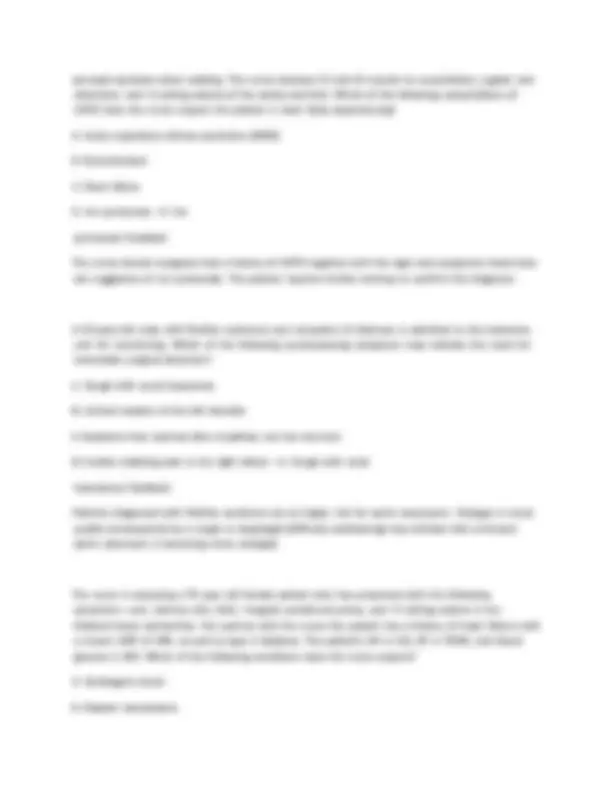
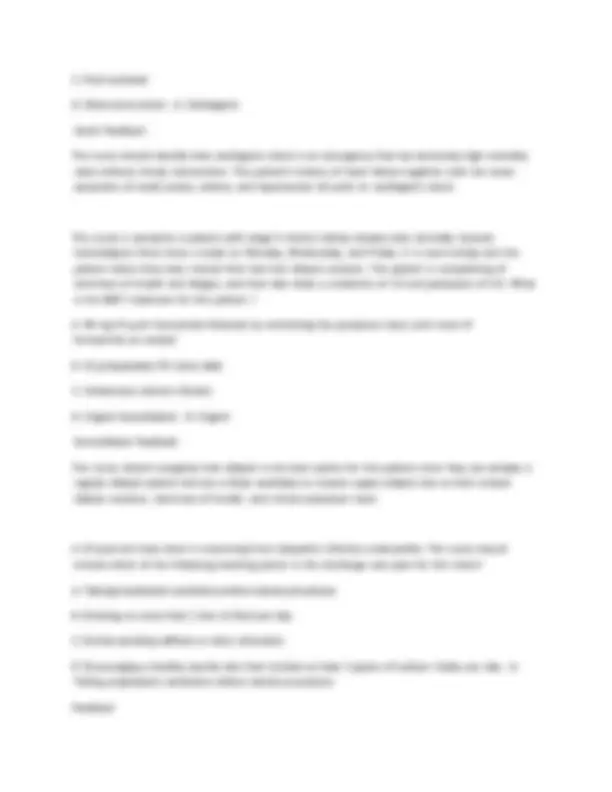
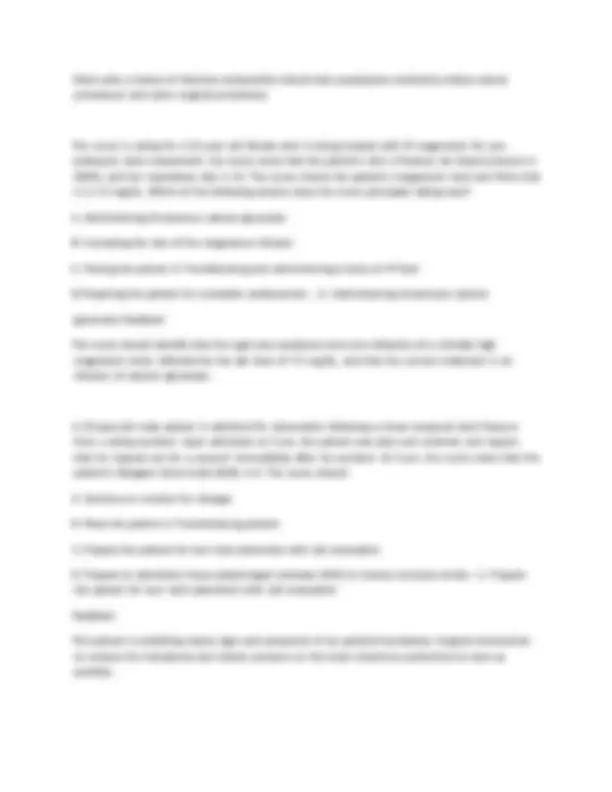
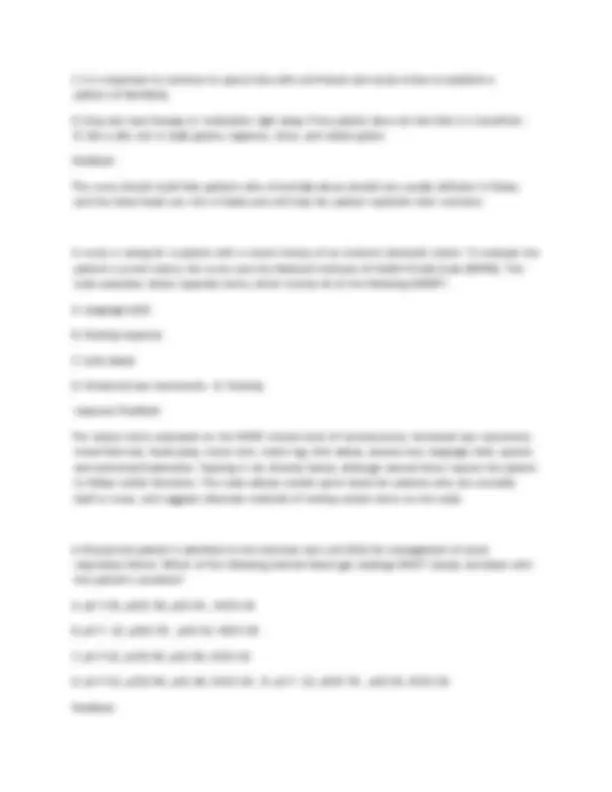

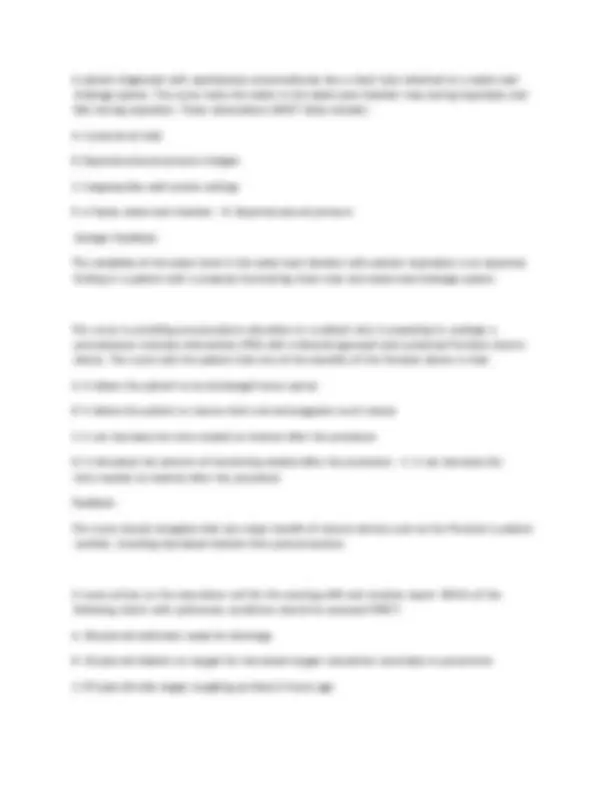
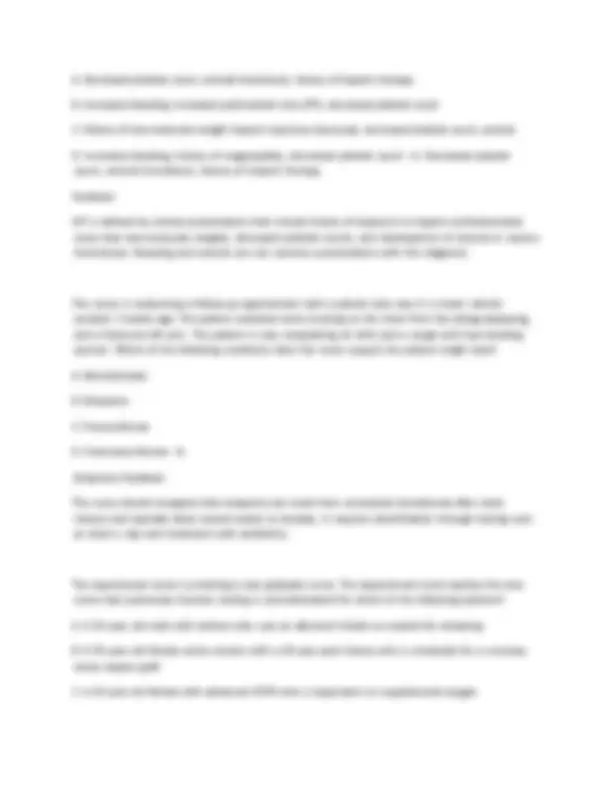
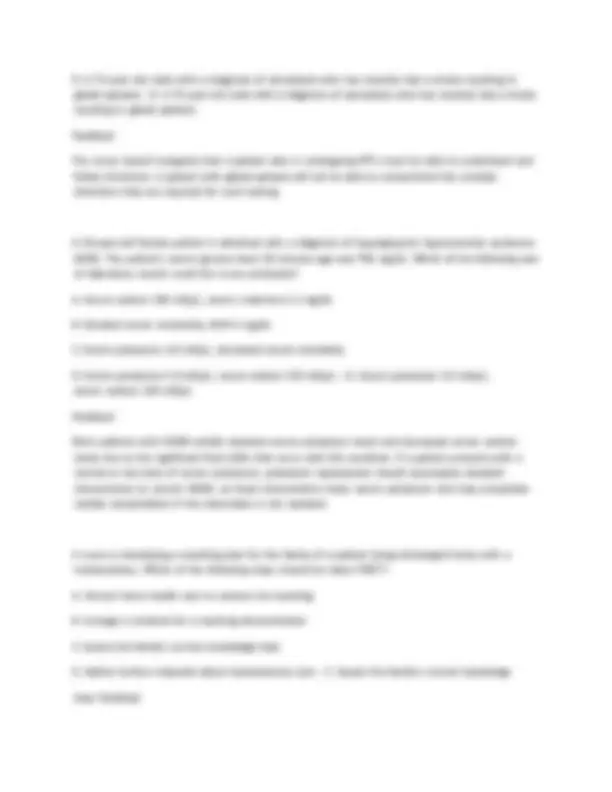
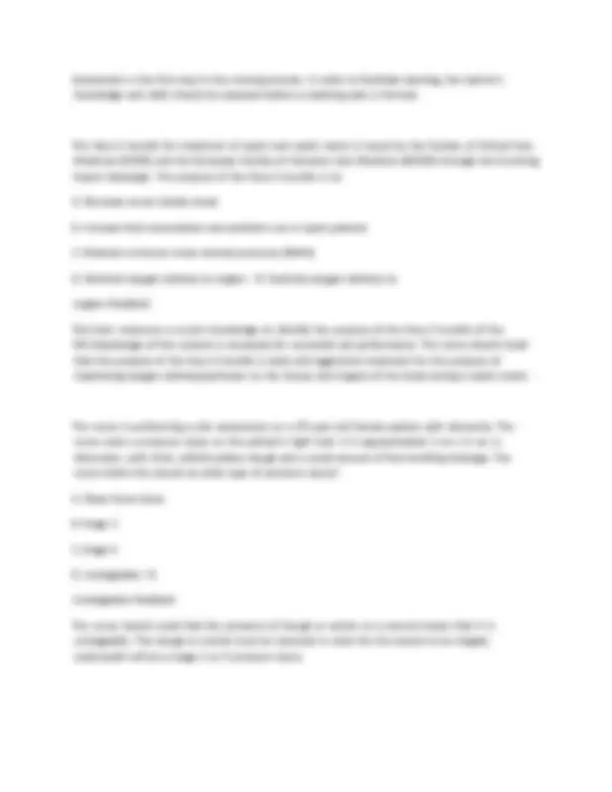
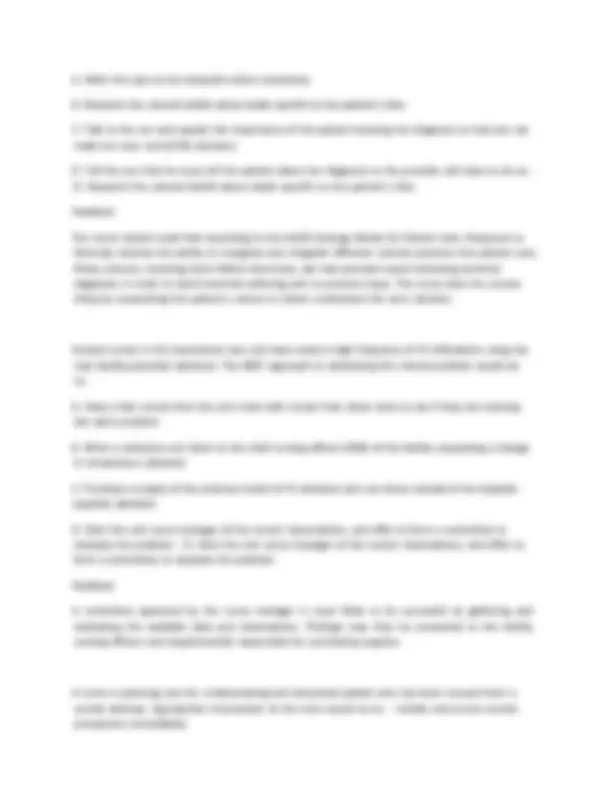
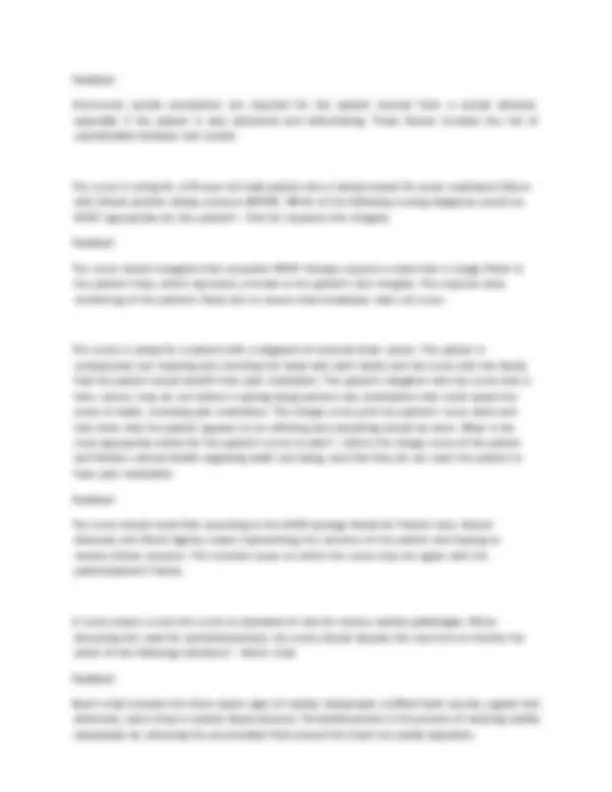
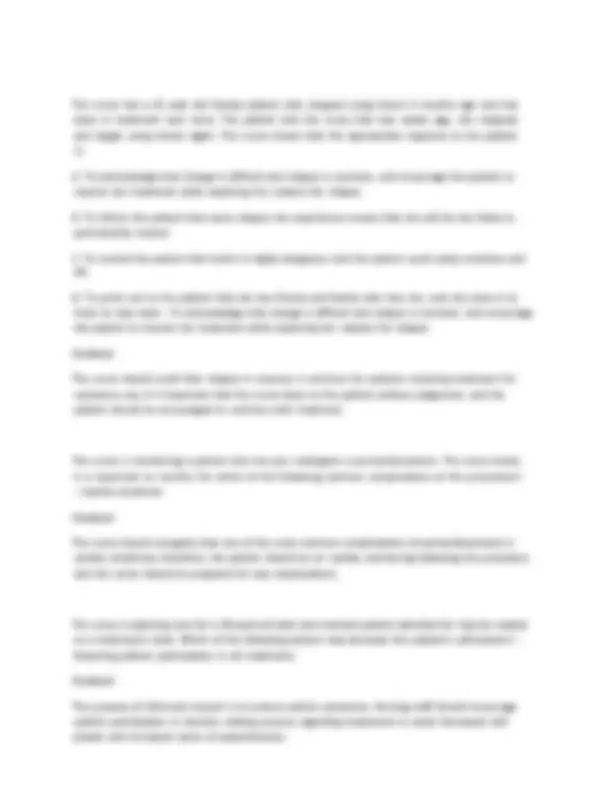
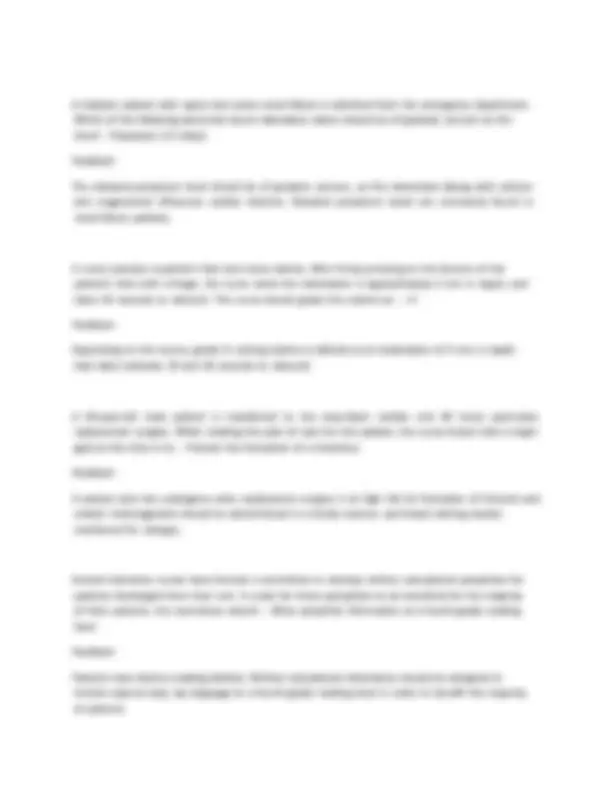
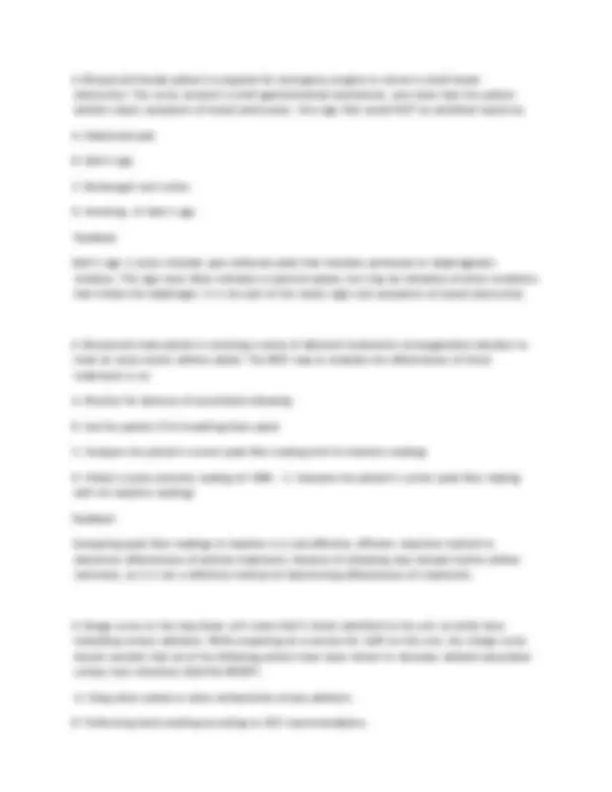
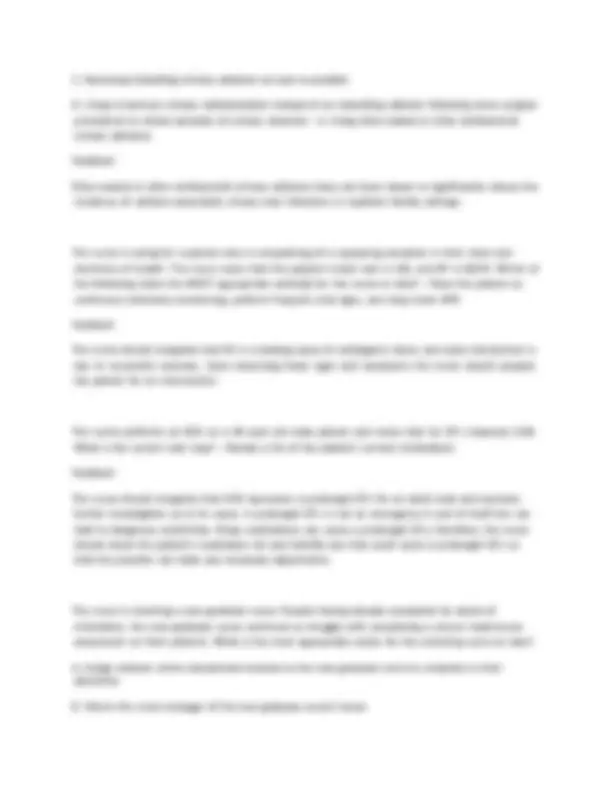
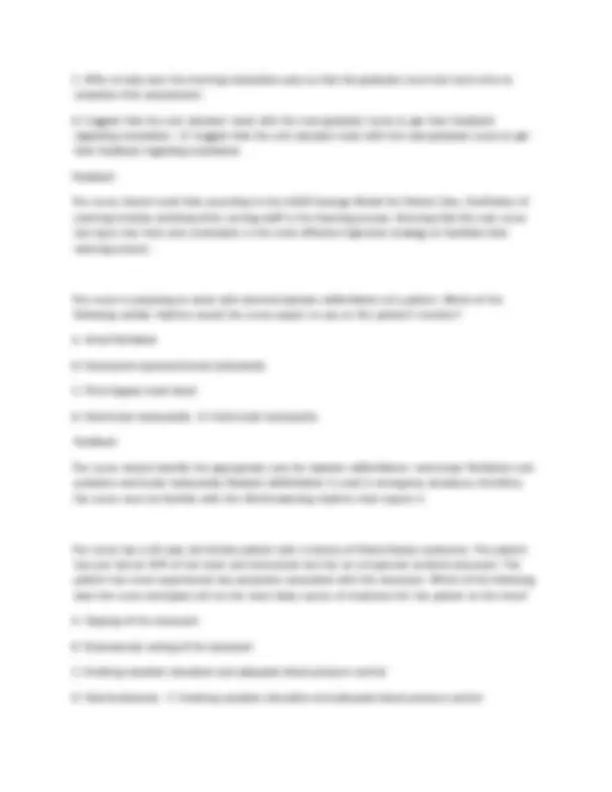
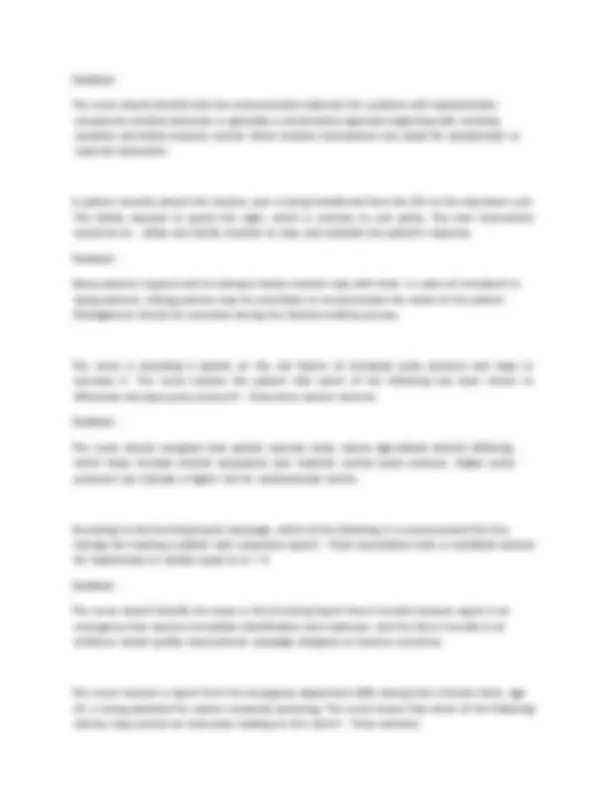
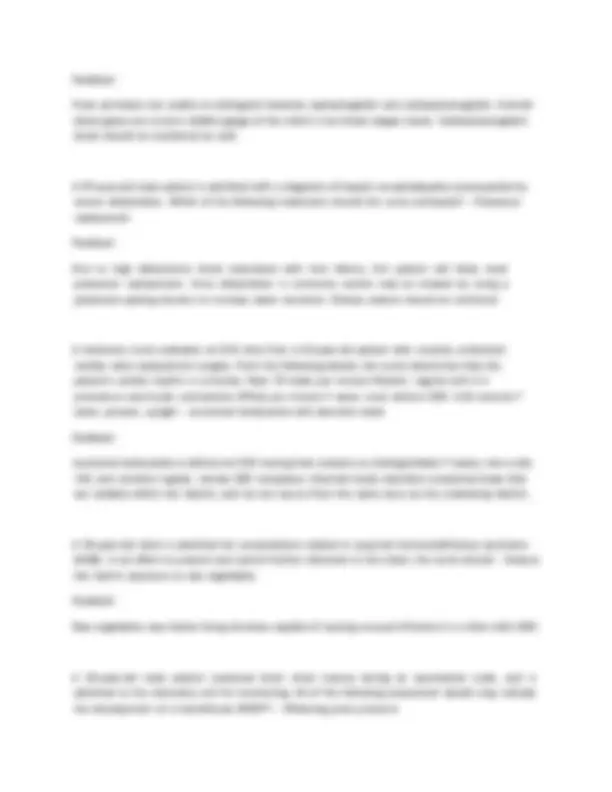
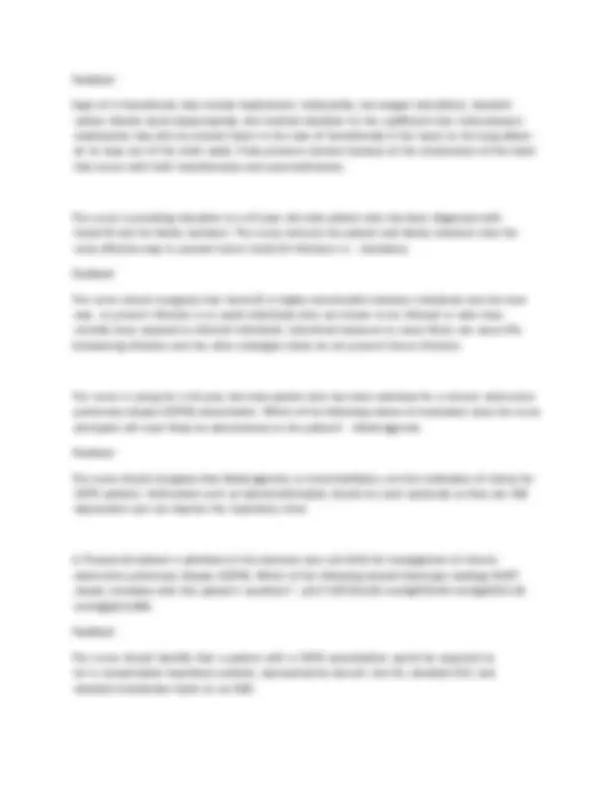
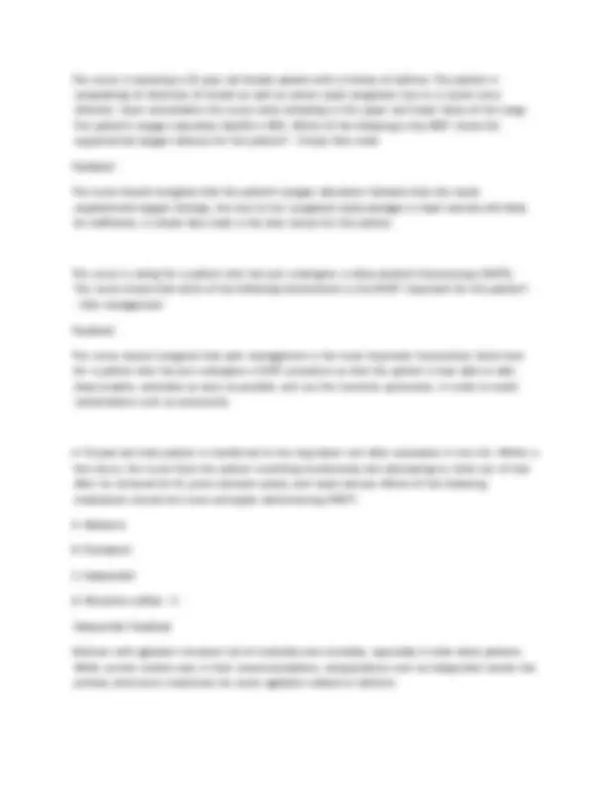
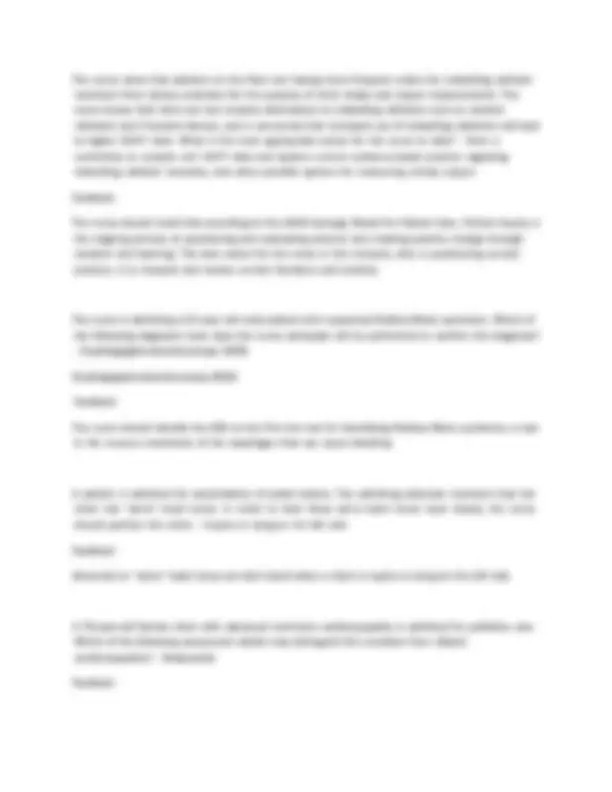
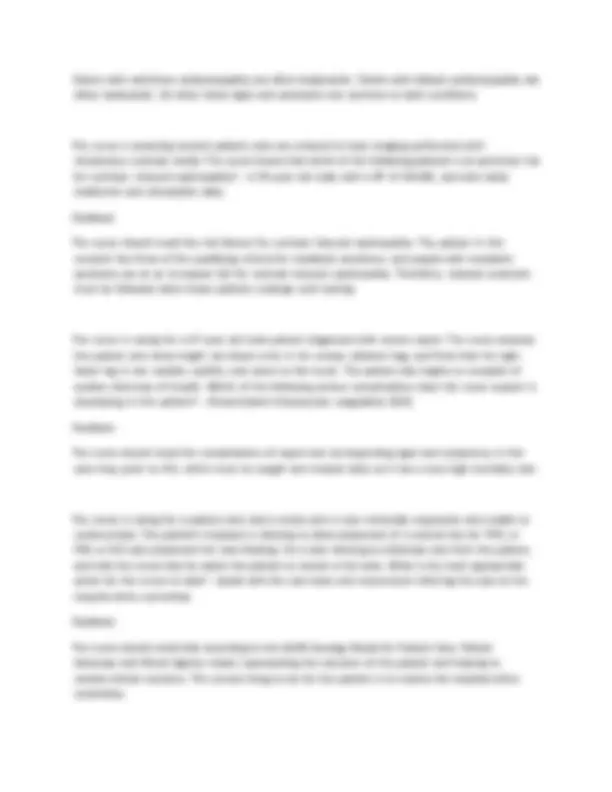
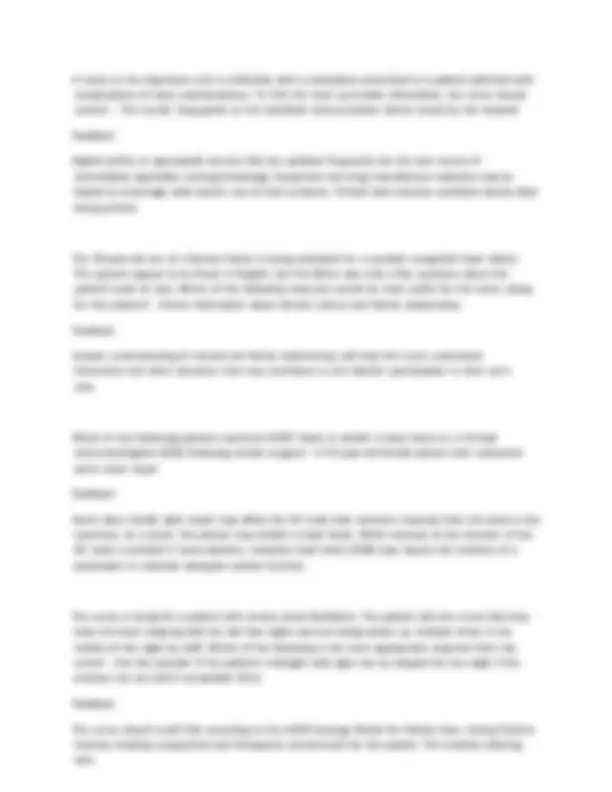
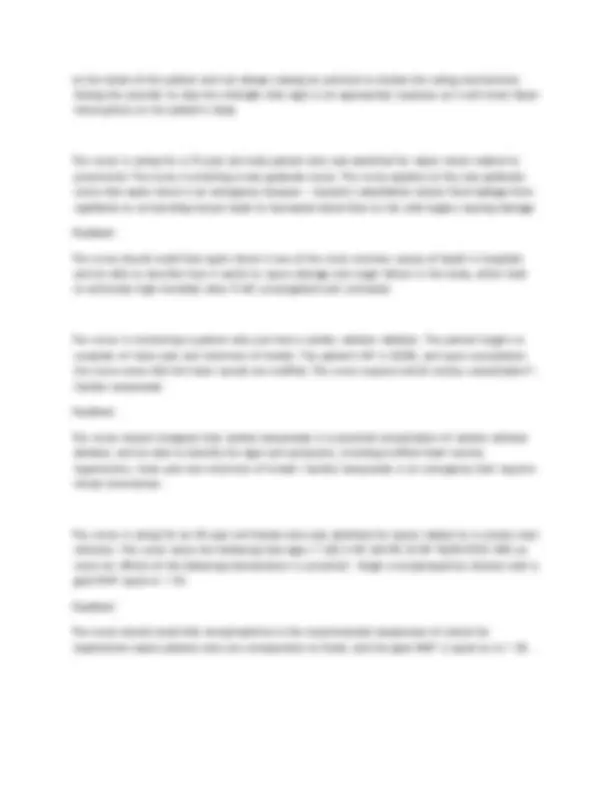
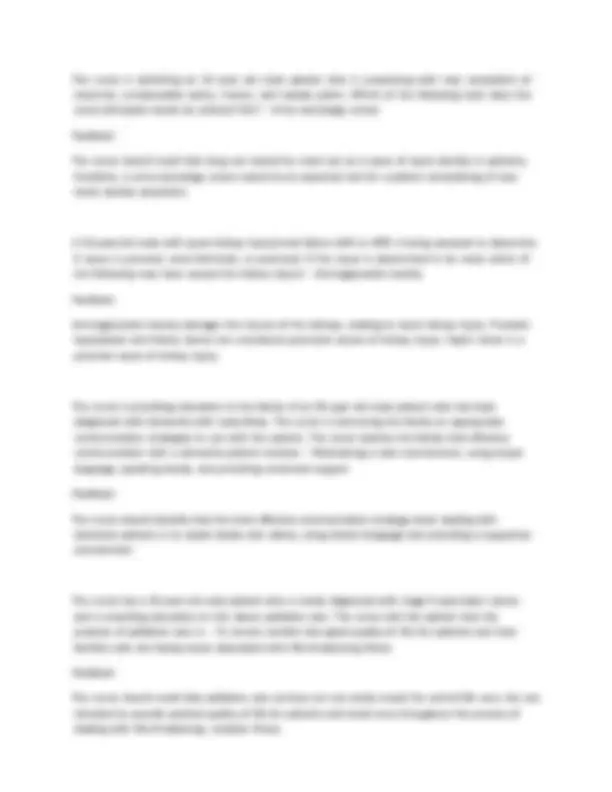
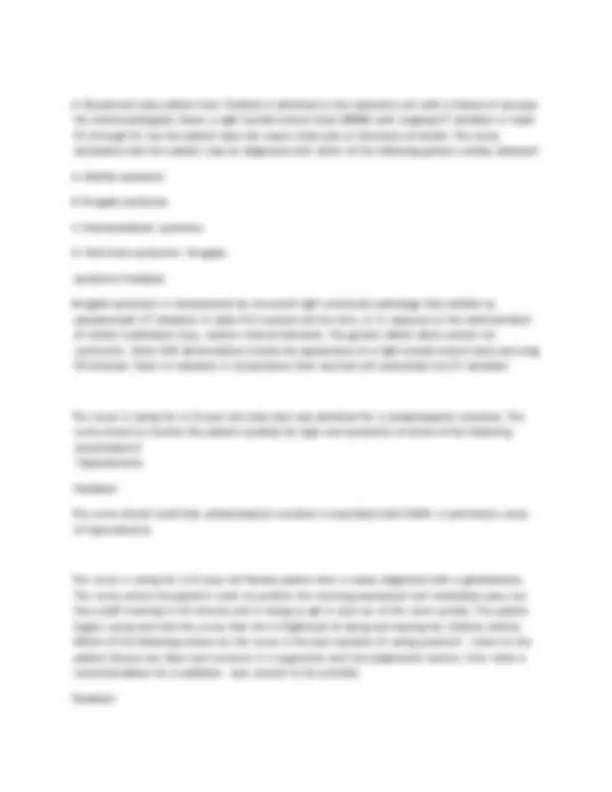
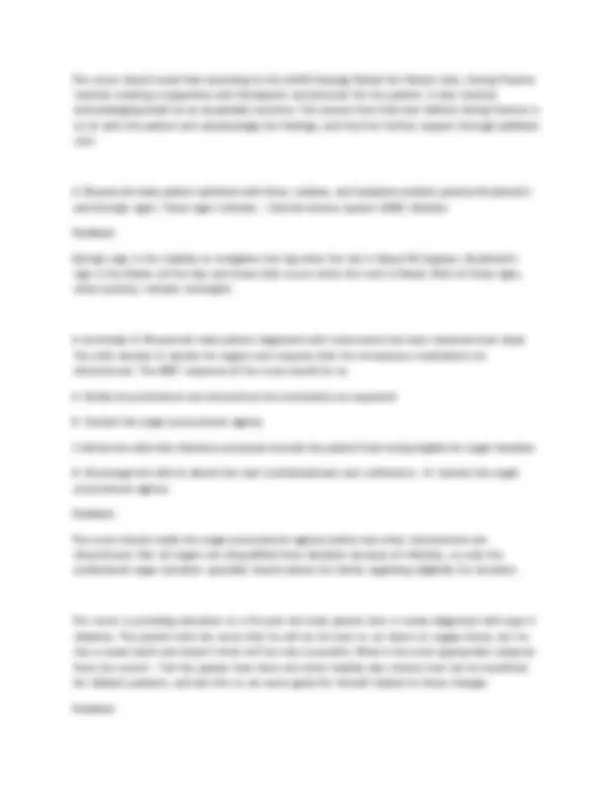
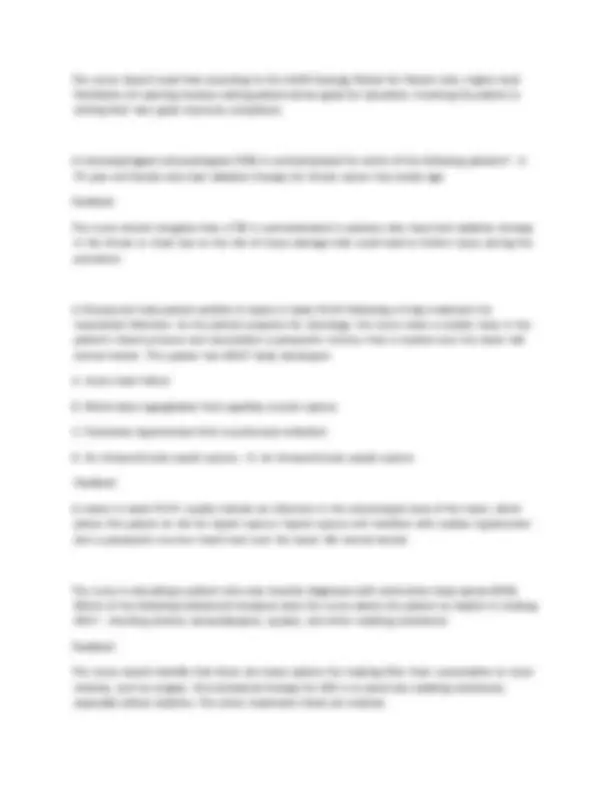
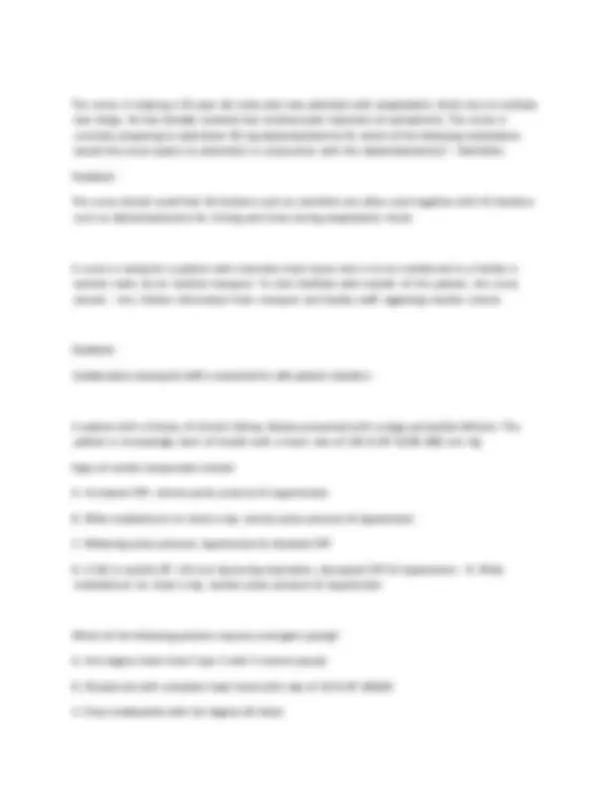
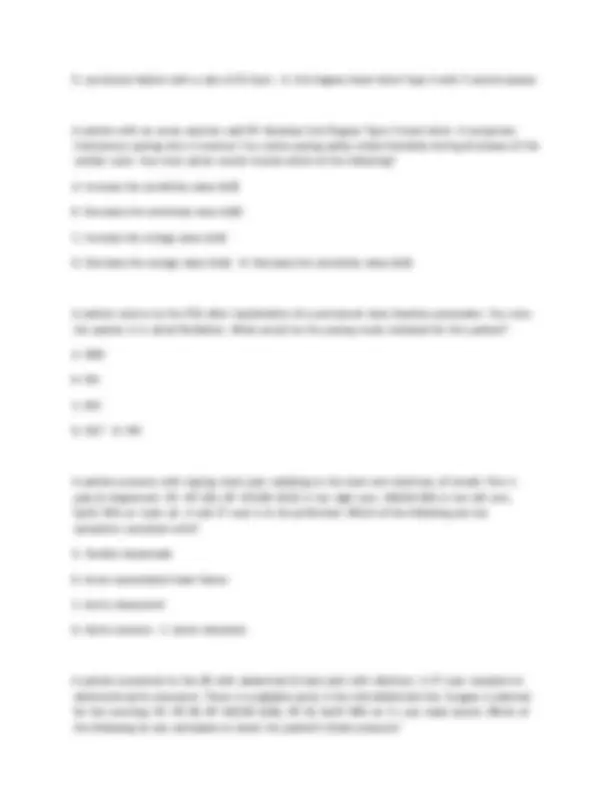
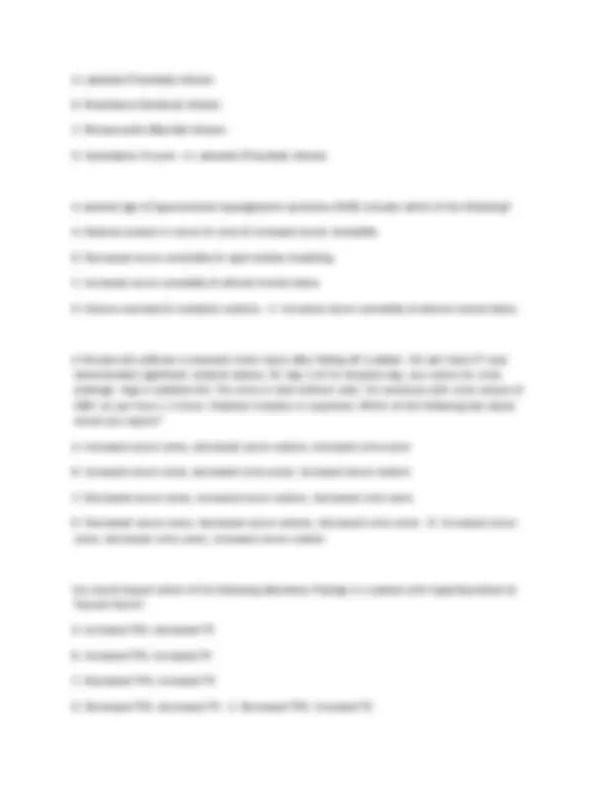
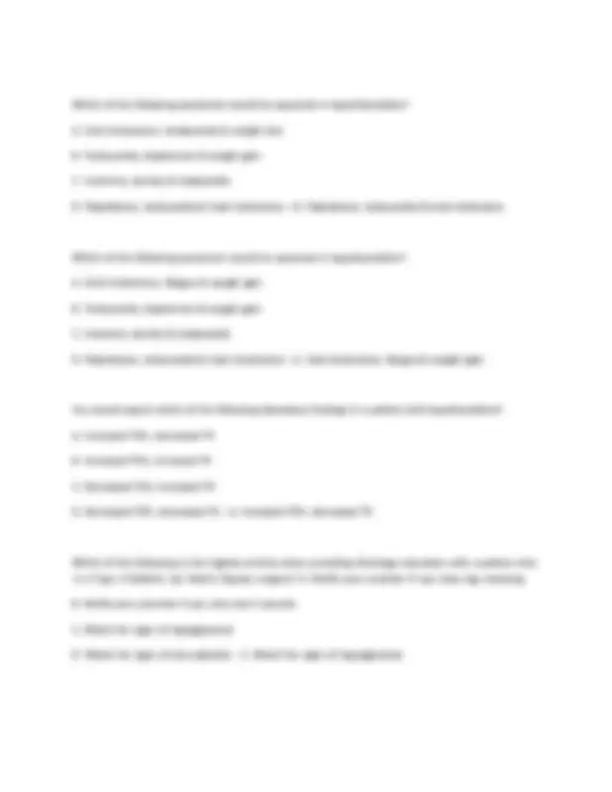
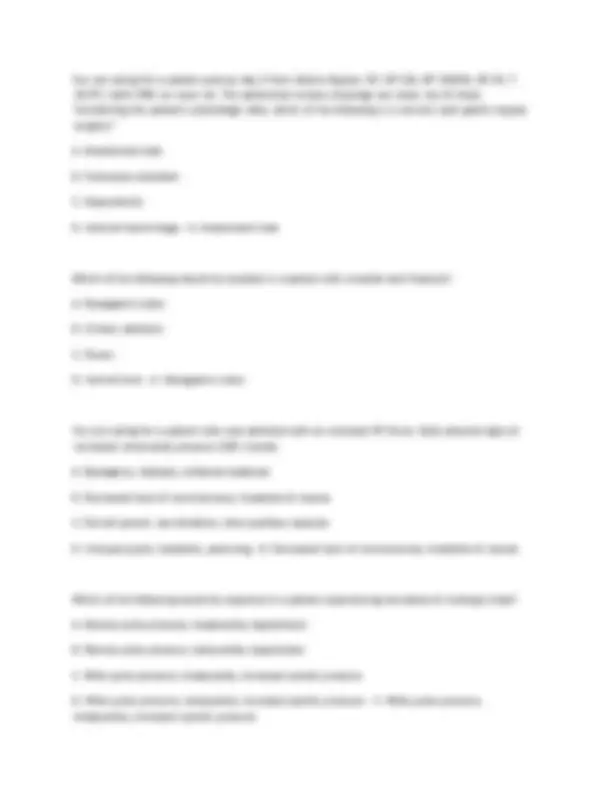
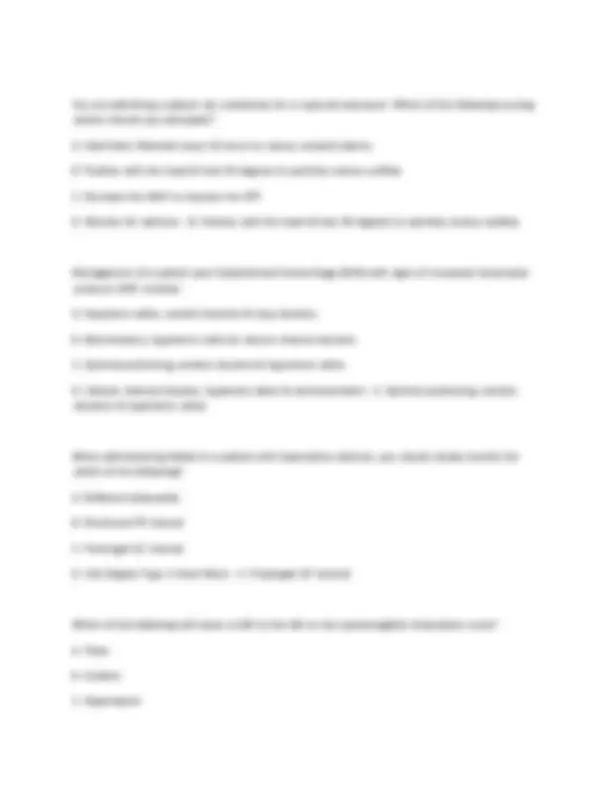
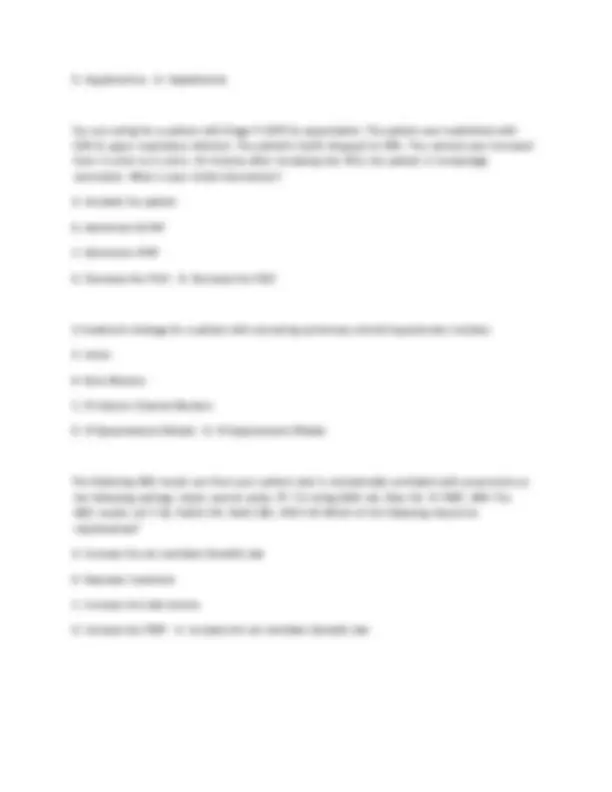


Study with the several resources on Docsity

Earn points by helping other students or get them with a premium plan


Prepare for your exams
Study with the several resources on Docsity

Earn points to download
Earn points by helping other students or get them with a premium plan
Community
Ask the community for help and clear up your study doubts
Discover the best universities in your country according to Docsity users
Free resources
Download our free guides on studying techniques, anxiety management strategies, and thesis advice from Docsity tutors
PCCN 2025 Exam NK review complete update.
Typology: Exams
1 / 43

This page cannot be seen from the preview
Don't miss anything!




































A .nurse .is .caring .for .a .71-year-old .female .patient .with .end-stage .chronic .obstructive .pulmonary .disease .(COPD) .who .is .experiencing .cardiac .ischemia .with .increased .shortness .of .breath. .The .MOST .appropriate .goal .of .oxygen .therapy .for .this .patient .would .be .to:
A. Limit .supplemental .oxygen .to .lower .the .risk .of .reducing .respiratory .drive
B. Maintain .oxygen .saturations .between .86% .and .89%
C. Administer .oxygen .until .oxygen .saturations .are .greater .than .95% .in .order .to .relieve .ischemia
D. Maintain .oxygen .saturations .between .90% .and .92% .- .D. .Maintain .oxygen .saturations .between .90% .and .92%
Feedback
Maintaining .oxygen .saturations .between .90% .and .92% .will .serve .the .purpose .of .providing .enough .oxygen .to .relieve .cardiac .ischemia .while .reducing .the .risk .of .respiratory .depression .in .a .patient .with .COPD.
Laboratory .studies .from .a .22-year-old .male .client .with .Type .I .diabetes .mellitus .are .evaluated .during .an .admission .for .severe .pneumonia. .Which .of .the .following .laboratory .results .should .the .nurse .report .to .the .physician?
A. Glycosylated .hemoglobin .(HbA1c), .9.8%
B. Low-density .lipoprotein .(LDL),
C. 94 .mg/dLHematocrit .(Hct), .53%
D. Urine .specific .gravity, .1.250 .- .A. .Glycosylated .hemoglobin .(HbA1c),
.9.8% .Feedback
Glycosylated .hemoglobin .measures .the .average .blood .sugar .levels .over .a. 2 .to. 3 .month .time .period. .Clients .with .previously .diagnosed .diabetes .mellitus .should .aim .to .keep .their .HbA1c .levels .below .7%.CONTENT .AREA: .Clinical .Judgement: .Endocrine/Hematology/Neurology/GI/Renal
The .nurse .is .assessing .a. 68 .year .old .female .patient .with .a .history .of .chronic .obstructive .pulmonary .disease .(COPD). .The .patient .presents .with .complaints .of .recent .confusion, .increased .fatigue, .and
C. Fluid .overload
D. Obstructive .shock .- .A. .Cardiogenic
.shock .Feedback
The .nurse .should .identify .that .cardiogenic .shock .is .an .emergency .that .has .extremely .high .mortality .rates .without .timely .intervention. .The .patient's .history .of .heart .failure .together .with .her .acute .symptoms .of .weak .pulses, .edema, .and .hypotension .all .point .to .cardiogenic .shock.
The .nurse .is .caring .for .a .patient .with .stage. 5 .chronic .kidney .disease .who .normally .receives .hemodialysis .three .times .a .week .on .Monday, .Wednesday, .and .Friday. .It .is .now .Sunday .and .the .patient .states .they .have .missed .their .last .two .dialysis .sessions. .The .patient .is .complaining .of .shortness .of .breath .and .fatigue, .and .their .labs .show .a .creatinine .of .3.9 .and .potassium .of .6.8. .What .is .the .BEST .treatment .for .this .patient .?
A. 80 .mg .IV .push .furosemide .followed .by .rechecking .the .potassium .level, .with .more .IV .furosemide .as .needed
B. 15 .g .kayexalate .PO .twice .daily
C. Intravenous .calcium .infusion
D. Urgent .hemodialysis .- .D. .Urgent
.hemodialysis .Feedback
The .nurse .should .recognize .that .dialysis .is .the .best .option .for .this .patient .since .they .are .already .a .regular .dialysis .patient .and .are .a .likely .candidate .to .receive .urgent .dialysis .due .to .their .missed .dialysis .sessions, .shortness .of .breath, .and .critical .potassium .level.
A .17-year-old .male .client .is .recovering .from .idiopathic .infective .endocarditis. .The .nurse .should .include .which .of .the .following .teaching .points .in .the .discharge .care .plan .for .this .client?
A. Taking .prophylactic .antibiotics .before .dental .procedures
B. Drinking .no .more .than. 1 .liter .of .fluid .per .day
C. Strictly .avoiding .caffeine .or .other .stimulants
D. Encouraging .a .healthy .low-fat .diet .that .includes .at .least. 2 .grams .of .sodium .intake .per .day .- .A. .Taking .prophylactic .antibiotics .before .dental .procedures
Feedback
Client .with .a .history .of .infective .endocarditis .should .take .prophylactic .antibiotics .before .dental .procedures .and .some .surgical .procedures.
The .nurse .is .caring .for .a. 21 .year .old .female .who .is .being .treated .with .IV .magnesium .for .pre- eclampsia. .Upon .assessment, .the .nurse .notes .that .the .patient's .skin .is .flushed, .her .blood .pressure .is .88/56, .and .her .respiratory .rate .is .12. .The .nurse .checks .the .patient's .magnesium .level .and .finds .that .it .is .7.2 .mg/dL. .Which .of .the .following .actions .does .the .nurse .anticipate .taking .next?
A. Administering .intravenous .calcium .gluconate
B. Increasing .the .rate .of .the .magnesium .infusion
C. Placing .the .patient .in .Trendelenburg .and .administering .a .bolus .of .IV .fluid
D. Preparing .the .patient .for .a .bedside .cardioversion. .- .A. .Administering .intravenous .calcium
.gluconate .Feedback
The .nurse .should .identify .that .the .signs .and .symptoms .here .are .reflective .of .a .critically .high .magnesium .level, .reflected .by .the .lab .level .of .7.2 .mg/dL, .and .that .the .correct .treatment .is .an .infusion .of .calcium .gluconate.
A .22-year-old .male .patient .is .admitted .for .observation .following .a .linear .temporal .skull .fracture .from .a .skiing .accident. .Upon .admission .at. 2 .pm, .the .patient .was .alert .and .oriented, .and .reports .that .he ."passed .out .for .a .second" .immediately .after .his .accident. .At. 4 .pm, .the .nurse .notes .that .the .patient's .Glasgow .Coma .Scale .(GCS) .is .8. .The .nurse .should:
A. Continue .to .monitor .for .changes
B. Place .the .patient .in .Trendelenburg .position
C. Prepare .the .patient .for .burr .hole .placement .with .clot .evacuation
D. Prepare .to .administer .tissue .plasminogen .activator .(tPA) .to .reverse .occlusive .stroke .- .C. .Prepare .the .patient .for .burr .hole .placement .with .clot .evacuation
Feedback
This .patient .is .exhibiting .classic .signs .and .symptoms .of .an .epidural .hematoma. .Surgical .intervention .to .remove .the .hematoma .and .relieve .pressure .on .the .brain .should .be .performed .as .soon .as .possible.
patient .loses .consciousness. .The .cardiac .monitor .reveals .third-degree .AV .heart .block .with .ventricular .escape .beats .at. 38 .beats .per .minute .(bpm). .The .nurse .should:
A. Prepare .to .initiate .transcutaneous .pacing
B. Administer .atropine .0.5 .mg .IV
C. Prepare .the .patient .for .cardioversion
D. Administer .adenosine .(Adenocard). 6 .mg .rapid .IV .push .- .A. .Prepare .to .initiate .transcutaneous
.pacing .Feedback
Third-degree .heart .block .with .a .slow .ventricular .escape .rhythm .that .is .not .sufficient .to .keep .a .patient .alert .should .be .immediately .addressed .by .transcutaneous .pacing .to .provide .adequate .brain .perfusion .(and .perfusion .of .other .organs). .Medications .should .be .administered .per .ACLS .protocols .or .as .directed .by .a .health .care .practitioner.
The .nurse .is .educating .a. 24 .year .old .patient .who .has .been .diagnosed .with .diabetic .gastroparesis. .The .nurse .teaches .the .patient .that .which .of .the .following .lifestyle .modifications .will .be .helpful .and .appropriate?
A. Drink .carbonated .beverages .regularly
B. Eat .a .diet .high .in .insoluble .fiber
C. Eat .fewer, .larger .meals .every .day
D. Ensure .well-controlled .blood .glucose .levels .- .D. .Ensure .well-controlled .blood .glucose
.levels .Feedback
The .nurse .should .know .that .ensuring .well-controlled .blood .glucose .levels .is .one .of .the .most .helpful .strategies .for .diabetic .gastroparesis. .The .other .three .strategies .listed .are .all .contraindicated .and .can .make .the .condition .worse.
The .nurse .is .providing .discharge .education .to .a. 47 .year .old .male .patient .who .was .admitted .for .acute .alcohol .withdrawal. .The .patient .tells .the .nurse .that .his .intent .is .to .pursue .outpatient .treatment .for .alcohol .use .disorder. .Which .of .the .following .teaching .points .is .appropriate .for .this .patient?
A. Alcoholics .Anonymous .is .the .only .support .group .that .will .really .help .a ."true" .alcoholic
B. Eat .a .diet .rich .in .leafy .greens, .legumes, .citrus, .and .whole .grains
C. It .is .important .to .continue .to .spend .time .with .old .friends .and .social .circles .to .establish .a .pattern .of .familiarity
D. Stop .any .new .therapy .or .medication .right .away .if .the .patient .does .not .feel .that .it .is .beneficial .- .B. .Eat .a .diet .rich .in .leafy .greens, .legumes, .citrus, .and .whole .grains
Feedback
The .nurse .should .recall .that .patients .who .chronically .abuse .alcohol .are .usually .deficient .in .folate, .and .the .listed .foods .are .rich .in .folate .and .will .help .the .patient .replenish .their .nutrients.
A .nurse .is .caring .for .a .patient .with .a .recent .history .of .an .ischemic .(embolic) .stroke. .To .evaluate .the .patient's .current .status, .the .nurse .uses .the .National .Institutes .of .Health .Stroke .Scale .(NIHSS). .This .scale .evaluates .eleven .separate .items, .which .include .all .of .the .following .EXCEPT:
A. Language .skills
B. Hearing .response
C. Limb .ataxia
D. Horizontal .eye .movements .- .B. .Hearing
.response .Feedback
The .eleven .items .evaluated .on .the .NIHSS .include .level .of .consciousness, .horizontal .eye .movement, .visual .field .test, .facial .palsy, .motor .arm, .motor .leg, .limb .ataxia, .sensory .loss, .language .skills, .speech, .and .extinction/inattention. .Hearing .is .not .directly .tested, .although .several .items .require .the .patient .to .follow .verbal .directions. .The .scale .advises .certain .point .levels .for .patients .who .are .normally .deaf .or .mute, .and .suggests .alternate .methods .of .testing .certain .items .on .the .scale.
A .43-year-old .patient .is .admitted .to .the .intensive .care .unit .(ICU) .for .management .of .acute .respiratory .failure. .Which .of .the .following .arterial .blood .gas .readings .MOST .closely .correlates .with .this .patient's .condition?
A. pH .7.24, .pCO2 .58, .pO2. 84 ., .HCO3. 24
B. pH .7. .22, .pCO2. 70 ., .pO2 .52, .HCO3. 28
C. pH .7.22, .pCO2 .45, .pO2 .90, .HCO3. 16
D. pH .7.32, .pCO2 .44, .pO2 .68, .HCO3. 20 .- .B. .pH .7. .22, .pCO2. 70 ., .pO2 .52, .HCO3. 28
Feedback
A .patient .diagnosed .with .spontaneous .pneumothorax .has .a .chest .tube .attached .to .a .water-seal .drainage .system. .The .nurse .notes .the .water .in .the .water-seal .chamber .rises .during .inspiration .and .falls .during .expiration. .These .observations .MOST .likely .indicate:
A. A .pleural .air .leak
B. Expected .pleural .pressure .changes
C. Inappropriate .wall .suction .settings
D. A .faulty .water-seal .chamber .- .B. .Expected .pleural .pressure
.changes .Feedback
The .variability .of .the .water .level .in .the .water-seal .chamber .with .patient .respiration .is .an .expected .finding .in .a .patient .with .a .properly .functioning .chest .tube .and .water-seal .drainage .system.
The .nurse .is .providing .pre-procedure .education .to .a .patient .who .is .preparing .to .undergo .a .percutaneous .coronary .intervention .(PCI) .with .a .femoral .approach .and .a .planned .Perclose .closure .device. .The .nurse .tells .the .patient .that .one .of .the .benefits .of .the .Perclose .device .is .that:
A. It .allows .the .patient .to .be .discharged .home .sooner
B. It .allows .the .patient .to .resume .their .oral .anticoagulant .much .sooner
C. It .can .decrease .the .time .needed .on .bedrest .after .the .procedure
D. It .decreases .the .amount .of .monitoring .needed .after .the .procedure .- .C. .It .can .decrease .the .time .needed .on .bedrest .after .the .procedure
Feedback
The .nurse .should .recognize .that .one .major .benefit .of .closure .devices .such .as .the .Perclose .is .patient .comfort, .including .decreased .bedrest .time .post-procedure.
A .nurse .arrives .on .the .step-down .unit .for .the .evening .shift .and .receives .report. .Which .of .the .following .clients .with .pulmonary .conditions .should .be .assessed .FIRST?
A. 20-year-old .asthmatic .ready .for .discharge
B. 32-year-old .diabetic .on .oxygen .for .decreased .oxygen .saturations .secondary .to .pneumonia
C. 47-year-old .who .began .coughing .up .blood. 2 .hours .ago
D. 55-year-old .with .atelectasis .postoperative .to .a .laparoscopic .appendectomy .- .C. .47-year-old .who .began .coughing .up .blood. 2 .hours .ago
Feedback
Patients .who .have .recently .exhibited .acute .change(s) .in .condition .should .be .assessed .before .clients .ready .for .discharge .or .those .in .stable .condition.
The .nurse .is .discharging .a .patient .on .sacubitril/valsartan, .which .is .a .new .medication .for .the .patient. .The .patient .tells .the .nurse .that .their .insurance .company .will .not .cover .this .medication .and .the .patient .cannot .afford .to .pay .for .it .out .of .pocket. .Which .of .the .following .would .be .the .best .action .for .the .nurse .to .take?
A. Ask .a .family .member .of .the .patient .if .they .are .able .to .help .contribute .to .the .cost .of .the .medication
B. Call .the .provider .and .tell .them .that .they .will .need .to .prescribe .something .else .instead
C. Give .the .patient .a .coupon .for .a .free. 30 .day .supply .of .the .medication .and .tell .them .to .explore .the .appeals .process .with .their .insurance .company .to .see .if .they .can .get .the .price .lowered
D. Speak .with .the .hospital .pharmacist .and .ask .if .there .is .a .more .affordable .alternative .medication .that .would .be .appropriate .for .the .patient, .then .notify .the .provider .of .this .recommendation .- .D. .Speak .with .the .hospital .pharmacist .and .ask .if .there .is .a .more .affordable .alternative .medication .that .would .be .appropriate .for .the .patient, .then .notify .the .provider .of .this .recommendation
Feedback
The .nurse .should .recall .that .according .to .the .AACN .Synergy .Model .for .Patient .Care, .Collaboration .encourages .involvement .and .contributions .of .other .members .of .the .team .and .discussions .regarding .patient .care.
A .charge .nurse .is .managing .bed .placement .for .patients .newly .admitted .to .the .unit. .A .hospitalized .patient .with .anorexia .nervosa .and .in .a .state .of .starvation .is .in .a .two-bed .hospital .room. .Which .of .the .following .patients .would .be .MOST .inappropriate .to .assign .to .this .two-bed .room?
A. A .patient .with .a .fractured .leg .that .is .casted
B. A .patient .who .is .receiving .tube .feedings
C. A .patient .with .community-acquired .pneumonia
D. A .patient .who .is .scheduled .for .a .diagnostic .test .- .C. .A .patient .with .community-acquired
.pneumonia .Feedback
A. Decreased .platelet .count, .arterial .thrombosis, .history .of .heparin .therapy
B. Increased .bleeding, .increased .prothrombin .time .(PT), .decreased .platelet .count
C. History .of .low-molecular .weight .heparin .injections .(Lovenox), .decreased .platelet .count, .anemia
D. Increased .bleeding, .history .of .coagulopathy, .decreased .platelet .count .- .A. .Decreased .platelet .count, .arterial .thrombosis, .history .of .heparin .therapy
Feedback
HIT .is .defined .by .clinical .presentations .that .include .history .of .exposure .to .heparin .(unfractionated .more .than .low-molecular .weight), .decreased .platelet .counts, .and .development .of .arterial .or .venous .thromboses. .Bleeding .and .anemia .are .not .common .presentations .with .this .diagnosis.
The .nurse .is .conducting .a .follow-up .appointment .with .a .patient .who .was .in .a .motor .vehicle .accident. 3 .weeks .ago. .The .patient .sustained .some .bruising .on .the .chest .from .the .airbag .deploying, .and .a .fractured .left .arm. .The .patient .is .now .complaining .of .chills .and .a .cough .with .foul-smelling .sputum. .Which .of .the .following .conditions .does .the .nurse .suspect .the .patient .might .have?
A. Bronchiectasis
B. Empyema
C. Pneumothorax
D. Pulmonary .fibrosis .- .B.
.Empyema .Feedback
The .nurse .should .recognize .that .empyema .can .result .from .unresolved .hemothorax .after .chest .trauma .and .typically .takes .several .weeks .to .develop. .It .requires .identification .through .testing .such .as .chest .x .rays .and .treatment .with .antibiotics.
The .experienced .nurse .is .orienting .a .new .graduate .nurse. .The .experienced .nurse .teaches .the .new .nurse .that .pulmonary .function .testing .is .contraindicated .for .which .of .the .following .patients?
A. A. 14 .year .old .male .with .asthma .who .uses .an .albuterol .inhaler .as .needed .for .wheezing
B. A. 54 .year .old .female .active .smoker .with .a. 20 .year .pack .history .who .is .scheduled .for .a .coronary .artery .bypass .graft
C. A. 63 .year .old .female .with .advanced .COPD .who .is .dependent .on .supplemental .oxygen
D. A. 72 .year .old .male .with .a .diagnosis .of .sarcoidosis .who .has .recently .had .a .stroke .resulting .in .global .aphasia .- .D. .A. 72 .year .old .male .with .a .diagnosis .of .sarcoidosis .who .has .recently .had .a .stroke .resulting .in .global .aphasia
Feedback
The .nurse .should .recognize .that .a .patient .who .is .undergoing .PFTs .must .be .able .to .understand .and .follow .directions. .A .patient .with .global .aphasia .will .not .be .able .to .comprehend .the .complex .directions .that .are .required .for .such .testing.
A .26-year-old .female .patient .is .admitted .with .a .diagnosis .of .hyperglycemic .hyperosmolar .syndrome .(HHS). .The .patient's .serum .glucose .level. 30 .minutes .ago .was. 748 .mg/dL. .Which .of .the .following .sets .of .laboratory .results .could .the .nurse .anticipate?
A. Serum .sodium. 150 .mEq/L, .serum .creatinine .2.1 .mg/dL
B. Elevated .serum .osmolarity, .BUN. 6 .mg/dL
C. Serum .potassium .3.0 .mEq/L, .decreased .serum .osmolarity
D. Serum .potassium .5.9 .mEq/L, .serum .sodium. 129 .mEq/L .- .D. .Serum .potassium .5.9 .mEq/L, .serum .sodium. 129 .mEq/L
Feedback
Most .patients .with .HHNK .exhibit .elevated .serum .potassium .levels .and .decreased .serum .sodium .levels .due .to .the .significant .fluid .shifts .that .occur .with .this .condition. .If .a .patient .presents .with .a .normal .or .low .level .of .serum .potassium, .potassium .replacement .should .accompany .standard .interventions .to .correct .HHNK, .as .these .interventions .lower .serum .potassium .and .may .precipitate .cardiac .complications .if .the .electrolyte .is .not .replaced.
A .nurse .is .developing .a .teaching .plan .for .the .family .of .a .patient .being .discharged .home .with .a .tracheostomy. .Which .of .the .following .steps .should .be .taken .FIRST?
A. Consult .home .health .care .to .conduct .the .teaching
B. Arrange .a .schedule .for .a .teaching .demonstration
C. Assess .the .family's .current .knowledge .base
D. Gather .written .materials .about .tracheostomy .care .- .C. .Assess .the .family's .current .knowledge
.base .Feedback
A .25-year-old .male .client .is .admitted .with .a .diagnosis .of .pericarditis. .The .nurse .should .prepare .to .assist .with .a .pericardiocentesis .when .the .client .exhibits .which .of .the .following .signs .or .symptoms?
A. Pericardial .friction .rub
B. Sharp .chest .pain .over .the .sternal .area
C. Elevated .blood .C-reactive .protein .level
D. Pulsus .paradoxus .- .D. .Pulsus
.paradoxus .Feedback
Pulsus .paradoxus .is .defined .as .a .drop .of. 10 .mmHg .or .more .in .systolic .blood .pressure .during .inspiration. .Pulsus .paradoxus .is .an .indicator .of .cardiac .tamponade, .a .life-threatening .complication .of .pericarditis. .Other .listed .signs .and .symptoms .may .be .exhibited .by .a .client .with .pericarditis .with .or .without .cardiac .tamponade.
The .nurse .is .caring .for .a .Vietnamese .patient .who .is .a .practicing .Buddhist, .and .the .patient .passes .away. .The .family .is .present .and .requests .that .per .tradition, .the .body .be .left .undisturbed .in .the .hospital .bed .for .four .hours. .The .charge .nurse .informs .the .patient's .nurse .that .the .emergency .department .is .currently .full .and .badly .needs .beds .for .admitting .patients. .Which .of .the .following .is .the .most .appropriate .action .for .the .patient's .nurse .to .take?
A. Apologize .and .tell .the .family .that .the .bed .is .needed .for .another .family .and .the .body .must .be .moved .to .the .morgue
B. Inform .the .charge .nurse .of .the .patient .and .family's .cultural .practices .related .to .death .and .ask .that .the .patient's .body .be .allowed .to .remain .undisturbed .for .the .requested .four .hours
c. .Tell .the .family .that .the .body .must .be .moved .in .order .to .make .room .for .another .patient, .but .offer .the .family .the .opportunity .to .participate .in .post-mortem .care
D. .Tell .the .fa .- .B. .Inform .the .charge .nurse .of .the .patient .and .family's .cultural .practices .related .to .death .and .ask .that .the .patient's .body .be .allowed .to .remain .undisturbed .for .the .requested .four .hours
Feedback
The .nurse .should .recall .that .according .to .the .AACN .Synergy .Model .for .Patient .Care, .Response .to .Diversity .involves .the .ability .to .recognize .and .integrate .different .cultural .practices .into .patient .care. .The .nurse .understands .that .Buddhist .culture .states .that .the .body .must .remain .undisturbed .for .at .least .four .hours .to .give .the .soul .time .to .leave .the .body .and .educates .the .charge .nurse .on .the .patient .and .family's .cultural .standards .as .well.
A .60-year-old .male .patient .is .admitted .following .a .percutaneous .transluminal .coronary .angioplasty .(PTCA) .and .stent .placement .to .the .left .anterior .descending .(LAD) .artery. .During .shift .change .three .hours .later, .the .patient .complains .of .flank .pain. .Assessment .reveals .hypotension .and .tachycardia. .The .nurse .suspects:
A. .Dissecting .aortic .aneurysm
B. .A .pulmonary .embolism
C. .Stent .failure .with .acute .re-occlusion .of .the .LAD
D. .Retroperitoneal .hemorrhage .- .D. .Retroperitoneal .hemorrhage
.Feedback
Trauma .to .the .femoral/iliac .artery .during .insertion .of .the .angioplasty .catheter .may .result .in .retroperitoneal .bleeding. .Hypotension .and .tachycardia .are .signs .of .shock, .in .this .case, .hypovolemic .shock .due .to .blood .loss .into .the .retroperitoneal .space.
The .nurse .is .monitoring .a .53-year-old .female .patient .who .is .post .coronary .angiography .with .a .right .femoral .arterial .approach; .the .patient's .sheath .was .pulled. 40 .minutes .ago. .The .patient .begins .complaining .of .6/10 .pain .and .a .tingling .sensation .in .her .right .leg. .Upon .assessment, .the .nurse .notes .that .the .patient's .foot .is .pale .and .her .previously .palpable .pedal .pulses .are .no .longer .found .on .the .doppler. Which .of .the .following .actions .should .the .nurse .take?
A. .Administer .a. 1 .L .bolus .of .0.9% .NS .and .pain .medication
B. .Immediately .notify .the .provider .and .prepare .the .patient .for .a .possible .emergency .procedure
C. .Place .the .patient .in .Trendelenburg .position .and .obtain .a .12-lead .ECG
D. .Reassess .the .pedal .pulse .in. 15 .minutes .- .B. .Immediately .notify .the .provider .and .prepare .the .patient .for .a .possible .emergency .procedure
Feedback
The .nurse .should .recognize .that .these .are .symptoms .of .reduced .perfusion .to .the .affected .extremity .due .to .a .thromboembolism .or .other .complication, .and .constitute .an .emergency .that .might .require .surgical .intervention. .The .nurse .must .notify .the .provider .of .these .symptoms .immediately.
The .nurse .is .caring .for .an. 84 .year .old .Native .American .female .patient. .The .provider .informs .the .nurse .that .testing .has .shown .that .the .patient .has .a .terminal .illness, .but .the .patient's .son .has .requested .that .the .patient .not .be .informed .of .the .diagnosis. .What .is .the .most .appropriate .action .for .the .nurse .to .take?
Feedback
One-to-one .suicide .precautions .are .required .for .the .patient .rescued .from .a .suicide .attempt, .especially .if .the .patient .is .also .delusional .and .hallucinating. .These .factors .increase .the .risk .of .unpredictable .behavior .and .suicide.
The .nurse .is .caring .for .a. 59 .year .old .male .patient .who .is .being .treated .for .acute .respiratory .failure .with .bilevel .positive .airway .pressure .(BIPAP). .Which .of .the .following .nursing .diagnoses .would .be .MOST .appropriate .for .this .patient? .- .Risk .for .impaired .skin .integrity
Feedback
The .nurse .should .recognize .that .successful .BIPAP .therapy .requires .a .mask .that .is .snugly .fitted .to .the .patient's .face, .which .represents .a .threat .to .the .patient's .skin .integrity. .This .requires .close .monitoring .of .the .patient's .facial .skin .to .ensure .that .breakdown .does .not .occur.
The .nurse .is .caring .for .a .patient .with .a .diagnosis .of .terminal .brain .cancer. .The .patient .is .unresponsive .but .moaning .and .clutching .her .head .with .both .hands .and .the .nurse .tells .the .family .that .the .patient .would .benefit .from .pain .medication. .The .patient's .daughter .tells .the .nurse .that .in .their .culture, .they .do .not .believe .in .giving .dying .patients .any .medications .that .could .speed .the .onset .of .death, .including .pain .medication. .The .charge .nurse .pulls .the .patient's .nurse .aside .and .tells .them .that .the .patient .appears .to .be .suffering .and .something .should .be .done. .What .is .the .most .appropriate .action .for .the .patient's .nurse .to .take? .- .Inform .the .charge .nurse .of .the .patient .and .family's .cultural .beliefs .regarding .death .and .dying, .and .that .they .do .not .want .the .patient .to .have .pain .medication
Feedback
The .nurse .should .recall .that .according .to .the .AACN .Synergy .Model .for .Patient .Care, .Patient .Advocacy .and .Moral .Agency .means .representing .the .concerns .of .the .patient .and .helping .to .resolve .ethical .concerns. .This .includes .issues .on .which .the .nurse .may .not .agree .with .the .patient/patient's .family.
A .nurse .orients .a .new .hire .nurse .to .standards .of .care .for .various .cardiac .pathologies. .When .discussing .the .need .for .pericardiocentesis, .the .nurse .should .educate .the .new .hire .to .monitor .for .which .of .the .following .indicators? .- .Beck's .triad
Feedback
Beck's .triad .includes .the .three .classic .signs .of .cardiac .tamponade: .muffled .heart .sounds, .jugular .vein .distension, .and .a .drop .in .systolic .blood .pressure. .Pericardiocentesis .is .the .process .of .reducing .cardiac .tamponade .by .removing .the .accumulated .fluid .around .the .heart .via .needle .aspiration.
The .nurse .has .a. 21 .year .old .female .patient .who .stopped .using .heroin. 5 .months .ago .and .has .been .in .treatment .ever .since. .The .patient .tells .the .nurse .that .two .weeks .ago, .she .relapsed .and .began .using .heroin .again. .The .nurse .knows .that .the .appropriate .response .to .the .patient .is:
A. .To .acknowledge .that .change .is .difficult .and .relapse .is .common, .and .encourage .the .patient .to .resume .her .treatment .while .exploring .her .reasons .for .relapse
B. .To .inform .the .patient .that .every .relapse .she .experiences .means .that .she .will .be .less .likely .to .permanently .recover
C. .To .remind .the .patient .that .heroin .is .highly .dangerous .and .the .patient .could .easily .overdose .and .die
D. .To .point .out .to .the .patient .that .she .has .friends .and .family .who .love .her, .and .she .owes .it .to .them .to .stay .clean .- .To .acknowledge .that .change .is .difficult .and .relapse .is .common, .and .encourage .the .patient .to .resume .her .treatment .while .exploring .her .reasons .for .relapse
Feedback
The .nurse .should .recall .that .relapse .in .recovery .is .common .for .patients .receiving .treatment .for .substance .use; .it .is .important .that .the .nurse .listen .to .the .patient .without .judgement, .and .the .patient .should .be .encouraged .to .continue .with .treatment.
The .nurse .is .monitoring .a .patient .who .has .just .undergone .a .pericardiocentesis. .The .nurse .knows .it .is .important .to .monitor .for .which .of .the .following .common .complications .of .this .procedure? .- .Cardiac .arrythmia
Feedback
The .nurse .should .recognize .that .one .of .the .most .common .complications .of .pericardiocentesis .is .cardiac .arrythmia; .therefore, .the .patient .should .be .on .cardiac .monitoring .following .the .procedure .and .the .nurse .should .be .prepared .for .any .complications.
The .nurse .is .planning .care .for .a .25-year-old .alert .and .oriented .patient .admitted .for .injuries .related .to .a .motorcycle .crash. .Which .of .the .following .actions .may .decrease .this .patient's .self-esteem? .- .Requiring .patient .participation .in .all .treatments
Feedback
The .purpose .of .informed .consent .is .to .protect .patient .autonomy. .Nursing .staff .should .encourage .patient .participation .in .decision .making .process .regarding .treatments .to .avoid .decreased .self- esteem .and .increased .sense .of .powerlessness.